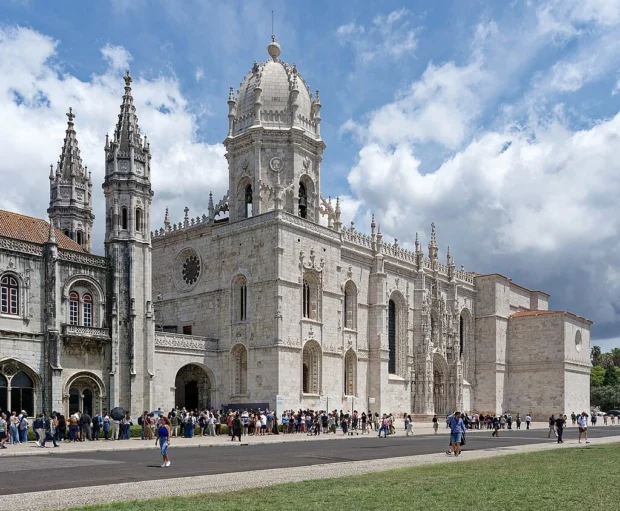Jerónimos Monastery stands as a colossal symbol of Lisbon’s rich maritime heritage and architectural grandeur. Nestled in the Belém district of Lisbon, Portugal, this masterpiece of Manueline architecture invites visitors to immerse themselves in tales of explorers, royal patronage, and artistic mastery. With its origins linked to the Age of Discoveries, Jerónimos Monastery is more than a religious site; it is a narrative carved in limestone that captures the ambitions of a burgeoning global empire. This guide will gently lead you through directions, visitor insights, historical significance, and practicalities of touring this magnificent site.
Table of Contents
How To Reach Jerónimos Monastery From Central Lisbon
Located about 7 kilometers west of downtown Lisbon, the monastery is easily accessible by various transport modes. From the city center, a tram ride offers a scenic approach, while buses provide direct routes.
Visitors typically take tram number 15 or 127 from Praça do Comércio or Cais do Sodré, which travel through the historic neighborhoods offering glimpses of local life en route to Belém. Alternatively, the train from Cais do Sodré to Belém station is a quicker option, followed by a pleasant 10-minute walk along the Tagus River. For travelers coming from Lisbon Airport, public transport involves a combination of metro to Cais do Sodré and then the train or tram towards Belém.
For those who prefer to explore on foot or by bike, the riverside promenade connecting central Lisbon to Belém offers a refreshing journey dotted with fountains, gardens, and street art.
Architectural Elegance of The Manueline Style
The design of Jerónimos Monastery is a study in the intricate and highly ornamental Manueline style-unique to Portugal. This architectural vocabulary emerged during King Manuel I’s reign in the early 16th century and reflects the dynamism of Portugal’s maritime expansion.
Step inside to marvel at lavishly detailed portals adorned with maritime motifs, such as ropes and sea creatures, interlaced with Christian symbolism. The monastery’s cloisters deserve particular attention; their rhythmic arches and elegant pillars wrap around lush gardens, each stone carved by master craftsmen to tell stories of exploration and faith. Notice how the sunlight filters through, casting patterns that change with the hours, enhancing the impression of delicate lacework sculpted in stone.
A Living Chronicle of Portugal’s Discoveries
Built to honor Vasco da Gama’s successful voyage to India, the monastery was commissioned by King Manuel I to serve both as a place for monks to pray for seafarers’ souls and a prestigious monument celebrating Portugal’s emerging global empire. The nearby Church of Santa Maria offers a final resting place for da Gama himself, drawing visitors intrigued by the blend of reverence and historical significance.
Planning Your Visit: Timings, Tickets, and Tours
Jerónimos Monastery opens its doors from Tuesday to Sunday, typically from 10 AM to 5:30 PM, closing on Mondays. The ideal time to visit is early morning or late afternoon on weekdays to avoid crowds and enjoy a more contemplative atmosphere.
Due to its popularity and limited daily capacity, pre-booking tickets online is highly advisable. This ensures entry without extended waiting and offers the option of guided tours that enrich the visit with historical context and architectural insights. Many tours include access to the monastery’s cloisters, church, and museum spaces.
Admission fees apply, but reduced prices are available for students, seniors, and Lisbon residents. Occasionally, free entry days align with national holidays or cultural events-these are highly popular and best planned for with patience or early arrival.
Official information and ticket reservations can be made through the monastery’s official website.
Neighbourhood Charm: Where To Stay and What To Eat Near Jerónimos Monastery
The Belém neighborhood is dotted with charming guesthouses and boutique lodgings, providing quieter alternatives to central Lisbon’s hustle. Staying nearby lets you absorb the district’s tranquil rhythms at dawn and stroll to the monastery before the crowds arrive.
After visiting Jerónimos Monastery, enjoy the city’s charm by reading about Lisbon’s warm colors and tastes in this lively Lisbon guide.
Post-visit, indulge in local culinary classics such as the famed pastéis de nata (custard tarts) at the nearby Pastéis de Belém bakery-a culinary institution itself. For savory delights, try freshly grilled bacalhau (salted cod) dishes in one of the riverside eateries where you can enjoy views of the Tagus harbor and passing sailboats.
Hidden Gems and Anecdotes Often Missed
While many admire the monastery’s grandeur, fewer realize that this complex also houses the Maritime Museum and the National Archaeology Museum, both under the same roof with a single ticket. These collections offer fascinating insights into Portugal’s seafaring history and ancient civilizations.
One quirky fact: the monastery’s construction spanned over a century, incorporating styles and materials from various periods. Some stones bear inscriptions or mason marks left by the craftsmen-a subtle signature tradition from medieval times. Look closely at columns and capitals, and you may spot these cryptic carvings that connect us to nameless artisans of the past.
Conservation Efforts and Architectural Legacy
Today, Jerónimos Monastery stands not only as a tourist destination but as a case study in grand architectural conservation. Restoration projects carefully balance preserving original elements with modern techniques to mitigate damage from weather and pollution. This commitment ensures that future generations will also experience the monument’s delicate stone lacework and historic ambience.
Final Thoughts: Beyond the Monastery Walls
Jerónimos Monastery invites you into a dialogue across centuries, where stones speak of ambition, artistry, and faith. Whether you arrive by tram, stroll along the river, or linger among the cloisters’ shadows, each moment here unfolds layers of Lisbon’s soul and Portugal’s seafaring might. By planning thoughtfully and embracing both well-known features and subtle details, visitors will find a profound connection to this architectural and historical treasure.

- Jerónimos Monastery in Belém, Lisbon, 20250604 1340 9256 by Jakub Hałun on Wikimedia Commons – cc by 4.0
